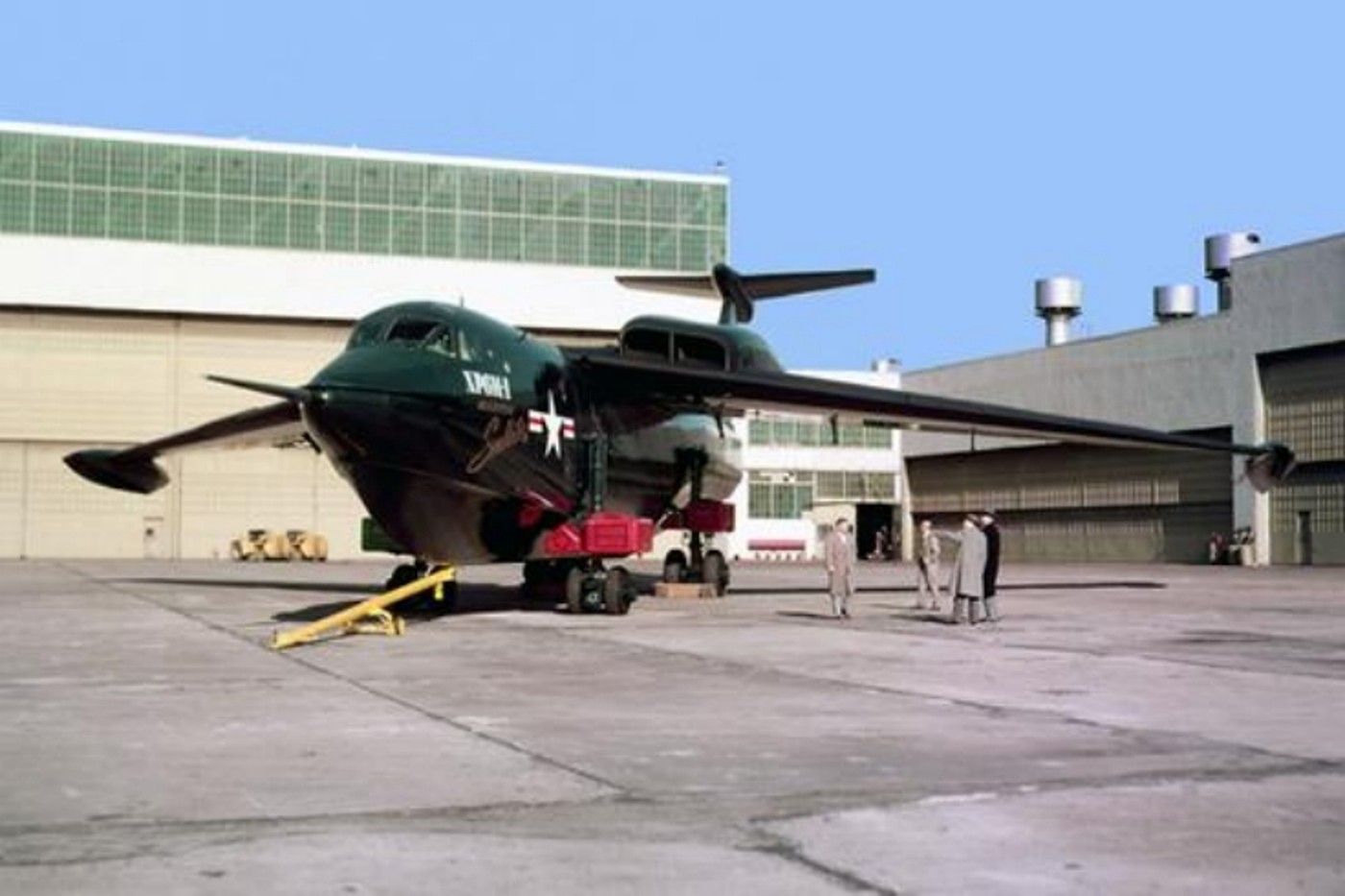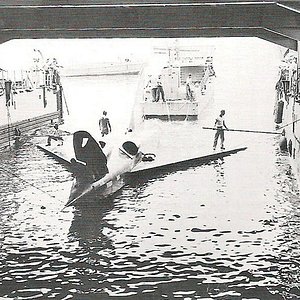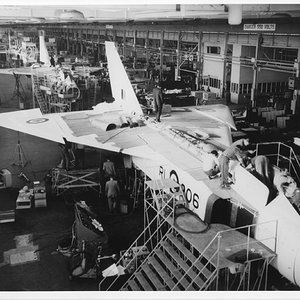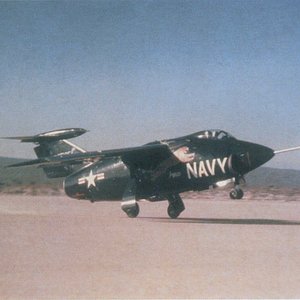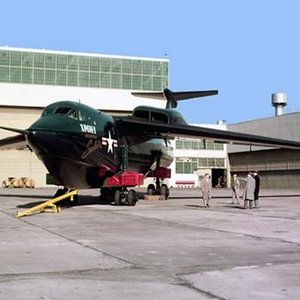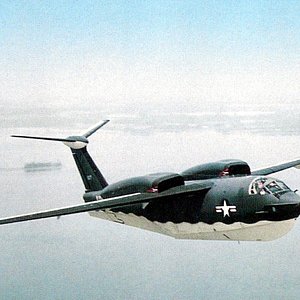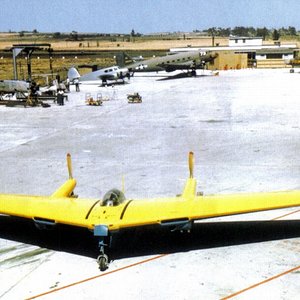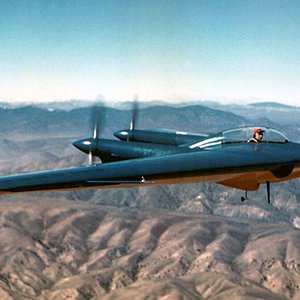Navigation
Install the app
How to install the app on iOS
Follow along with the video below to see how to install our site as a web app on your home screen.
Note: This feature may not be available in some browsers.
More options
You are using an out of date browser. It may not display this or other websites correctly.
You should upgrade or use an alternative browser.
You should upgrade or use an alternative browser.
Operational history
YP6M-1 in flight
P6M-2 after taxiing up a boat ramp
P6M-2 illustrating takeoff spray pattern
The first flight of the XP6M-1 came on 14 July 1955,[4] but early tests showed that the engines were mounted too close to the fuselage and scorched it when afterburners were used, leading to pointing the engines slightly outward in subsequent aircraft. Flight testing was initially successful, but, on 7 December 1955, a control system fault destroyed the first prototype with the loss of all aboard. The first prototype, BuNo 138821, c/n XP-1, disintegrated in flight at 5,000 feet due to the horizontal tail going to full up in control malfunction, subjecting the airframe to 9 g stress as it began an outside loop, crashing into the Potomac River near the junction of St. Mary's River, killing four crew members: Navy pilot Lieutenant Commander Utgoff, and Martin employees, Morris Bernhard, assistant pilot, Herbert Scudder, flight engineer, and H.B. Coulon, flight test engineer.[4]
Eleven months later, on 9 November 1956, the second prototype, BuNo 138822, c/n XP-2, first flown May 18, 1956, was also destroyed, due to a change made in the horizontal stabilizer control system without adequate evaluation before test flying the design. The crash occurred at 3:36 p.m. near Odessa, Delaware due to a faulty elevator jack. As the seaplane nosed up at ~21,000 feet and failed to respond to control inputs, the crew of four ejected, pilot Robert S. Turner, co-pilot William Cunningham, and two crew all parachuting to safety. The airframe broke up after falling to 6,000 feet before impact.[2][5]
The first pre-production YP6M-1 was completed about a year later, with testing resuming in January 1958.
Five more were built in 1958 when the Navy announced that Harvey Point Defense Testing Facility in Hertford, North Carolina, would serve as the testing grounds for the fleet of Martin P6M SeaMasters. These aircraft were fitted with test versions of the full combat equipment suite and were used for bombing, mine laying and reconnaissance evaluations. The P6M-1 test program was mostly successful, however the J71 engines proved far less reliable than required. The P6M-1 had spray ingestion problems at high gross weight which precluded takeoffs except under ideal conditions.[6] The P6M-1 also had a serious control deficiency due to porpoising under some trim settings.[7] These deficiencies resulted in the P6M-1 program being cut, as it was no longer considered possible for it to be a successful asset. The P6M-1 had been generally successful, the airplane was designed to meet a demanding set of specifications, and had mostly achieved them.
The Navy and Martin felt that a new version, the P6M-2 would provide a useful aircraft. The first was rolled out in early 1959. Changes included new, more powerful Pratt & Whitney J75 engines, an aerial refueling probe, improved avionics, and a canopy with better visibility. A buddy refueling drogue kit had also been developed to fit in the bomb bay. Three had been built by summer 1959 and Navy crews were moving them through operational conversion when the program was abruptly canceled in August of that year.
The P6M-2 was an impressive aircraft; its Mach 0.9 (1,100 km/h) performance "on the deck" could be equaled by few aircraft of the time, and few today. The planes were built incredibly tough, with the aircraft skin at the wing roots over one inch (25 mm) thick. The men managing the test program were shocked when the docile and pleasant handling characteristics of the P6M-1 were replaced by some severe compressibility effects above Mach 0.8. These included rapid changes in directional trim, severe buffeting, and wing drop requiring high control inputs to counter. Until those problems were fixed, the P6M-2 could not be considered for use by the Fleet.[8] The problems were caused by the larger engine nacelles required for the J75s. There were also problems on the water, including a tendency for the tip floats to dig in under certain situations, and engine surges. These problems were eventually solved, but time had run out for the SeaMaster just as the first crews were training for its operational debut. The major defense budget cuts of the Eisenhower administration were forcing the Navy to make choices. In August 1959 Martin was told to halt operations; the program was going to be canceled. Seaplanes were a small community in Naval Aviation, and the P6M, significantly over budget and behind schedule, was competing with aircraft carriers for funding. The Navy had an impending superior system for the nuclear strike role, the Fleet Ballistic Missile Submarine.
Although the technology of the P6M was phenomenal, in the age of the ICBM and SLBM, the manned bomber was considered an expensive, unreliable way to deliver nuclear weapons. The P6M program had already cost $400 million (about $2.5 billion in 2004 dollars) and could not be justified without the strategic mission.
All of the aircraft were scrapped. Some tail sections were retained for testing, and one of these is now in the Glenn L. Martin museum.
Martin tried unsuccessfully to market the technology in the civilian market, with a SeaMaster version called the SeaMistress but there were no takers,[9] and the company soon abandoned the aircraft business entirely to focus on missiles and electronics. The P6M was the final aircraft constructed by the Glenn L. Martin Company.
YP6M-1 in flight
P6M-2 after taxiing up a boat ramp
P6M-2 illustrating takeoff spray pattern
The first flight of the XP6M-1 came on 14 July 1955,[4] but early tests showed that the engines were mounted too close to the fuselage and scorched it when afterburners were used, leading to pointing the engines slightly outward in subsequent aircraft. Flight testing was initially successful, but, on 7 December 1955, a control system fault destroyed the first prototype with the loss of all aboard. The first prototype, BuNo 138821, c/n XP-1, disintegrated in flight at 5,000 feet due to the horizontal tail going to full up in control malfunction, subjecting the airframe to 9 g stress as it began an outside loop, crashing into the Potomac River near the junction of St. Mary's River, killing four crew members: Navy pilot Lieutenant Commander Utgoff, and Martin employees, Morris Bernhard, assistant pilot, Herbert Scudder, flight engineer, and H.B. Coulon, flight test engineer.[4]
Eleven months later, on 9 November 1956, the second prototype, BuNo 138822, c/n XP-2, first flown May 18, 1956, was also destroyed, due to a change made in the horizontal stabilizer control system without adequate evaluation before test flying the design. The crash occurred at 3:36 p.m. near Odessa, Delaware due to a faulty elevator jack. As the seaplane nosed up at ~21,000 feet and failed to respond to control inputs, the crew of four ejected, pilot Robert S. Turner, co-pilot William Cunningham, and two crew all parachuting to safety. The airframe broke up after falling to 6,000 feet before impact.[2][5]
The first pre-production YP6M-1 was completed about a year later, with testing resuming in January 1958.
Five more were built in 1958 when the Navy announced that Harvey Point Defense Testing Facility in Hertford, North Carolina, would serve as the testing grounds for the fleet of Martin P6M SeaMasters. These aircraft were fitted with test versions of the full combat equipment suite and were used for bombing, mine laying and reconnaissance evaluations. The P6M-1 test program was mostly successful, however the J71 engines proved far less reliable than required. The P6M-1 had spray ingestion problems at high gross weight which precluded takeoffs except under ideal conditions.[6] The P6M-1 also had a serious control deficiency due to porpoising under some trim settings.[7] These deficiencies resulted in the P6M-1 program being cut, as it was no longer considered possible for it to be a successful asset. The P6M-1 had been generally successful, the airplane was designed to meet a demanding set of specifications, and had mostly achieved them.
The Navy and Martin felt that a new version, the P6M-2 would provide a useful aircraft. The first was rolled out in early 1959. Changes included new, more powerful Pratt & Whitney J75 engines, an aerial refueling probe, improved avionics, and a canopy with better visibility. A buddy refueling drogue kit had also been developed to fit in the bomb bay. Three had been built by summer 1959 and Navy crews were moving them through operational conversion when the program was abruptly canceled in August of that year.
The P6M-2 was an impressive aircraft; its Mach 0.9 (1,100 km/h) performance "on the deck" could be equaled by few aircraft of the time, and few today. The planes were built incredibly tough, with the aircraft skin at the wing roots over one inch (25 mm) thick. The men managing the test program were shocked when the docile and pleasant handling characteristics of the P6M-1 were replaced by some severe compressibility effects above Mach 0.8. These included rapid changes in directional trim, severe buffeting, and wing drop requiring high control inputs to counter. Until those problems were fixed, the P6M-2 could not be considered for use by the Fleet.[8] The problems were caused by the larger engine nacelles required for the J75s. There were also problems on the water, including a tendency for the tip floats to dig in under certain situations, and engine surges. These problems were eventually solved, but time had run out for the SeaMaster just as the first crews were training for its operational debut. The major defense budget cuts of the Eisenhower administration were forcing the Navy to make choices. In August 1959 Martin was told to halt operations; the program was going to be canceled. Seaplanes were a small community in Naval Aviation, and the P6M, significantly over budget and behind schedule, was competing with aircraft carriers for funding. The Navy had an impending superior system for the nuclear strike role, the Fleet Ballistic Missile Submarine.
Although the technology of the P6M was phenomenal, in the age of the ICBM and SLBM, the manned bomber was considered an expensive, unreliable way to deliver nuclear weapons. The P6M program had already cost $400 million (about $2.5 billion in 2004 dollars) and could not be justified without the strategic mission.
All of the aircraft were scrapped. Some tail sections were retained for testing, and one of these is now in the Glenn L. Martin museum.
Martin tried unsuccessfully to market the technology in the civilian market, with a SeaMaster version called the SeaMistress but there were no takers,[9] and the company soon abandoned the aircraft business entirely to focus on missiles and electronics. The P6M was the final aircraft constructed by the Glenn L. Martin Company.

